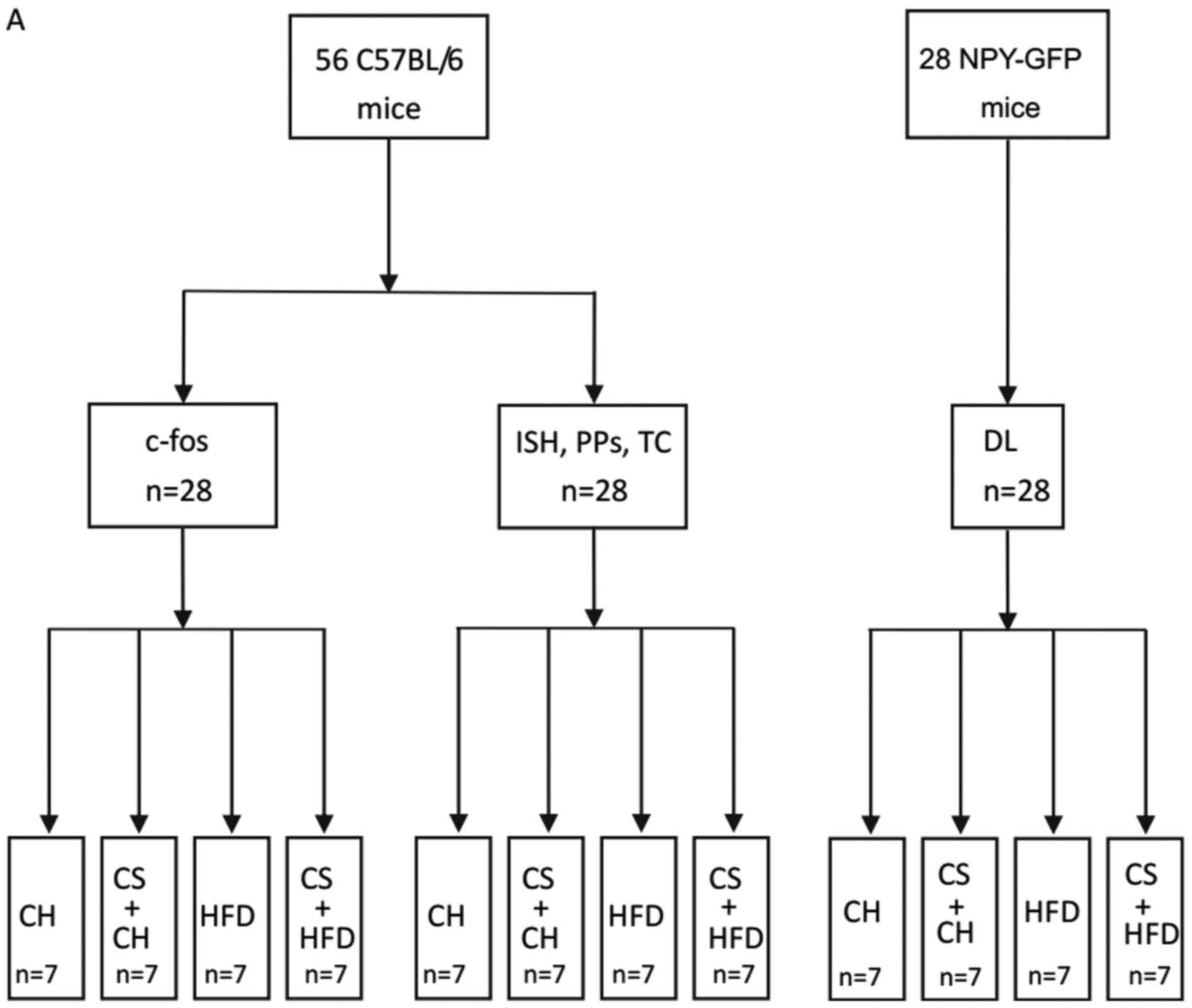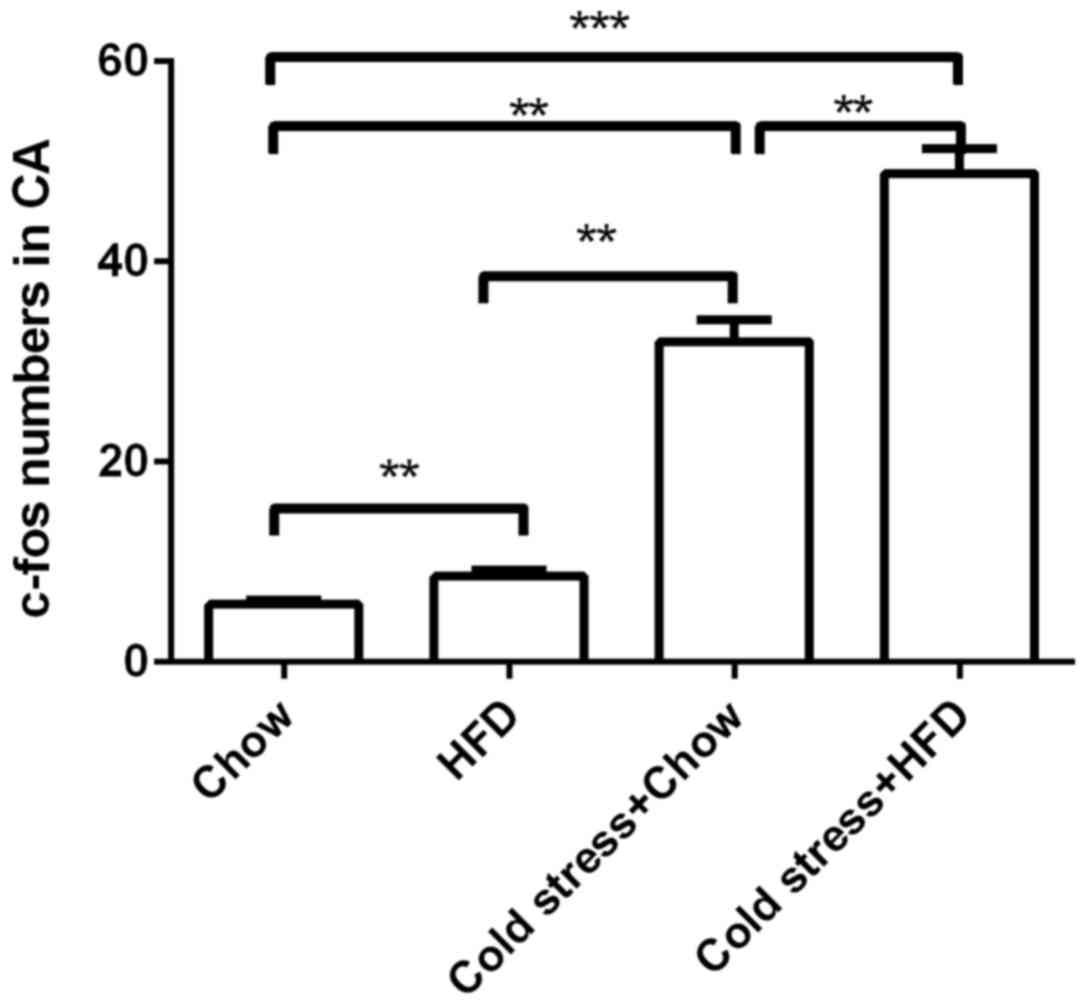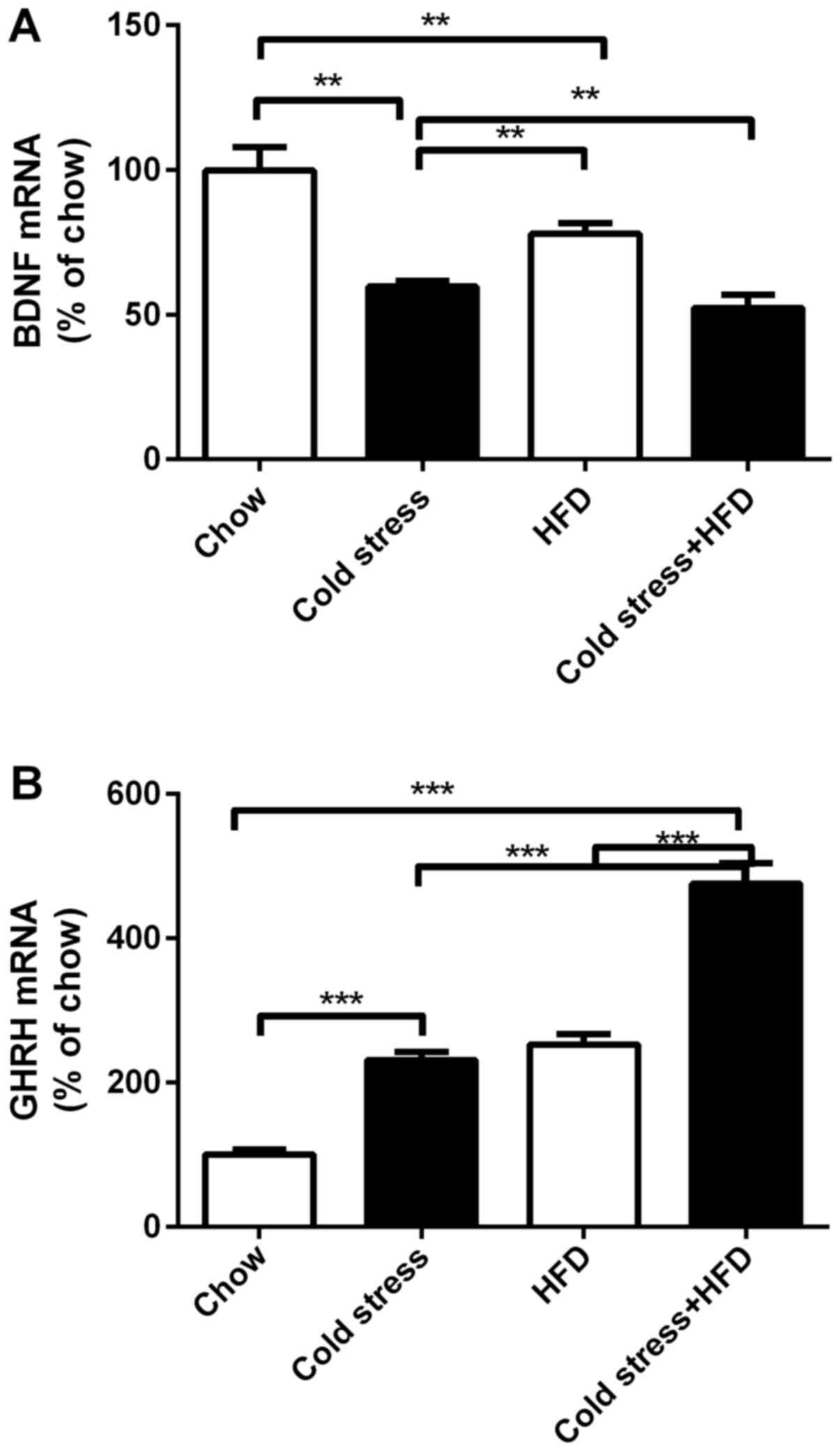|
1
|
NCD Risk Factor Collaboration (NCD-RisC),
. Trends in adult body-mass index in 200 countries from 1975 to
2014: A pooled analysis of 1698 population-based measurement
studies with 19·2 million participants. Lancet. 387:1377–1396.
2016. View Article : Google Scholar : PubMed/NCBI
|
|
2
|
Must A, Spadano J, Coakley EH, Field AE,
Colditz G and Dietz WH: The disease burden associated with
overweight and obesity. JAMA. 282:1523–1529. 1999. View Article : Google Scholar : PubMed/NCBI
|
|
3
|
Wan Y, Jiang X, He Y, Zhang Y, Liang Y,
Pan F, Xu Y and Shang L: Body mass index of young men in China:
Results from four national surveys conducted between 1955 and 2012.
Medicine (Baltimore). 95:e28292016. View Article : Google Scholar : PubMed/NCBI
|
|
4
|
Moon G, Quarendon G, Barnard S, Twigg L
and Blyth B: Fat nation: Deciphering the distinctive geographies of
obesity in England. Soc Sci Med. 65:20–31. 2007. View Article : Google Scholar : PubMed/NCBI
|
|
5
|
Batis C, Mendez MA, Gordon-Larsen P,
Sotres-Alvarez D, Adair L and Popkin B: Using both principal
component analysis and reduced rank regression to study dietary
patterns and diabetes in Chinese adults. Public Health Nutr.
19:195–203. 2016. View Article : Google Scholar : PubMed/NCBI
|
|
6
|
Watt C, Mitchell S and Salewski V:
Bergmann's rule; A concept cluster? Oikos. 119:89–100. 2010.
View Article : Google Scholar
|
|
7
|
Lidell ME, Betz MJ and Enerbäck S: Two
types of brown adipose tissue in humans. Adipocyte. 3:63–66. 2014.
View Article : Google Scholar : PubMed/NCBI
|
|
8
|
Abdullahi A and Jeschke MG: White adipose
tissue browning: A double-edged sword. Trends Endocrinol Metab.
27:542–552. 2016. View Article : Google Scholar : PubMed/NCBI
|
|
9
|
Lidell ME, Betz MJ and Enerbäck S: Brown
adipose tissue and its therapeutic potential. J Intern Med.
276:364–377. 2014. View Article : Google Scholar : PubMed/NCBI
|
|
10
|
Fedorenko A, Lishko PV and Kirichok Y:
Mechanism of fatty-acid-dependent UCP1 uncoupling in brown fat
mitochondria. Cell. 151:400–413. 2012. View Article : Google Scholar : PubMed/NCBI
|
|
11
|
Blondin DP, Labbé SM, Tingelstad HC, Noll
C, Kunach M, Phoenix S, Guérin B, Turcotte EE, Carpentier AC,
Richard D and Haman F: Increased brown adipose tissue oxidative
capacity in cold-acclimated humans. J Clin Endocrinol Metab.
99:E438–E446. 2014. View Article : Google Scholar : PubMed/NCBI
|
|
12
|
Van der Lans AA, Wierts R, Vosselman MJ,
Schrauwen P, Brans B and van Marken Lichtenbelt WD: Cold-activated
brown adipose tissue in human adults: Methodological issues. Am J
Physiol Regul Integr Comp Physiol. 307:R103–R113. 2014. View Article : Google Scholar : PubMed/NCBI
|
|
13
|
Chondronikola M, Volpi E, Børsheim E,
Porter C, Annamalai P, Enerbäck S, Lidell ME, Saraf MK, Labbe SM,
Hurren NM, et al: Brown adipose tissue improves whole-body glucose
homeostasis and insulin sensitivity in humans. Diabetes.
63:4089–4099. 2014. View Article : Google Scholar : PubMed/NCBI
|
|
14
|
Lee P, Smith S, Linderman J, Courville AB,
Brychta RJ, Dieckmann W, Werner CD, Chen KY and Celi FS:
Temperature-acclimated brown adipose tissue modulates insulin
sensitivity in humans. Diabetes. 63:3686–3698. 2014. View Article : Google Scholar : PubMed/NCBI
|
|
15
|
Trayhurn P: Recruiting brown adipose
tissue in human obesity. Diabetes. 65:1158–1160. 2016. View Article : Google Scholar : PubMed/NCBI
|
|
16
|
Kuperman Y, Weiss M, Dine J, Staikin K,
Golani O, Ramot A, Nahum T, Kühne C, Shemesh Y, Wurst W, et al:
CRFR1 in AgRP neurons modulates sympathetic nervous system activity
to adapt to cold stress and fasting. Cell Metab. 23:1185–1199.
2016. View Article : Google Scholar : PubMed/NCBI
|
|
17
|
Shi SY, Zhang W, Luk CT, Sivasubramaniyam
T, Brunt JJ, Schroer SA, Desai HR, Majerski A and Woo M: JAK2
promotes brown adipose tissue function and is required for diet-
and cold-induced thermogenesis in mice. Diabetologia. 59:187–196.
2016. View Article : Google Scholar : PubMed/NCBI
|
|
18
|
Wilson MA, Grillo CA, Fadel JR and Reagan
LP: Stress as a one-armed bandit: Differential effects of stress
paradigms on the morphology, neurochemistry and behavior in the
rodent amygdala. Neurobiol Stress. 1:195–208. 2015. View Article : Google Scholar : PubMed/NCBI
|
|
19
|
Loh K, Herzog H and Shi YC: Regulation of
energy homeostasis by the NPY system. Trends Endocrinol Metab.
26:125–135. 2015. View Article : Google Scholar : PubMed/NCBI
|
|
20
|
Stanley BG, Magdalin W, Seirafi A, Nguyen
MM and Leibowitz SF: Evidence for neuropeptide Y mediation of
eating produced by food deprivation and for a variant of the Y1
receptor mediating this peptide's effect. Peptides. 13:581–587.
1992. View Article : Google Scholar : PubMed/NCBI
|
|
21
|
Chen P, Lin D, Giesler J and Li C:
Identification of urocortin 3 afferent projection to the
ventromedial nucleus of the hypothalamus in rat brain. J Comp
Neurol. 519:2023–2042. 2011. View Article : Google Scholar : PubMed/NCBI
|
|
22
|
Liu X, Zhu Z, Kalyani M, Janik JM and Shi
H: Effects of energy status and diet on Bdnf expression in the
ventromedial hypothalamus of male and female rats. Physiol Behav.
130:99–107. 2014. View Article : Google Scholar : PubMed/NCBI
|
|
23
|
Correll CM, Rosenkranz JA and Grace AA:
Chronic cold stress alters prefrontal cortical modulation of
amygdala neuronal activity in rats. Biol Psychiatry. 58:382–391.
2005. View Article : Google Scholar : PubMed/NCBI
|
|
24
|
Eshkevari L, Permaul E and Mulroney SE:
Acupuncture blocks cold stress-induced increases in the
hypothalamus-pituitary-adrenal axis in the rat. J Endocrinol.
217:95–104. 2013. View Article : Google Scholar : PubMed/NCBI
|
|
25
|
van-Hover C and Li C: Stress-activated
afferent inputs into the anterior parvicellular part of the
paraventricular nucleus of the hypothalamus: Insights into
urocortin 3 neuron activation. Brain Res. 1611:29–43. 2015.
View Article : Google Scholar : PubMed/NCBI
|
|
26
|
Mormède P, Castagné V, Rivet JM, Gaillard
R and Corder R: Involvement of neuropeptide Y in neuroendocrine
stress responses. Central and peripheral studies. J Neural Transm
Suppl. 29:65–75. 1990.PubMed/NCBI
|
|
27
|
Lin S, Thomas TC, Storlien LH and Huang
XF: Development of high fat diet-induced obesity and leptin
resistance in C57Bl/6J mice. Int J Obes Relat Metab Disord.
24:639–646. 2000. View Article : Google Scholar : PubMed/NCBI
|
|
28
|
Shi YC, Lin S, Wong IP, Baldock PA,
Aljanova A, Enriquez RF, Castillo L, Mitchell NF, Ye JM, Zhang L,
et al: NPY neuron-specific Y2 receptors regulate adipose tissue and
trabecular bone but not cortical bone homeostasis in mice. PLoS
One. 5:e113612010. View Article : Google Scholar : PubMed/NCBI
|
|
29
|
Lin S, Shi YC, Yulyaningsih E, Aljanova A,
Zhang L, Macia L, Nguyen AD, Lin EJ, During MJ, Herzog H and
Sainsbury A: Critical role of arcuate Y4 receptors and the
melanocortin system in pancreatic polypeptide-induced reduction in
food intake in mice. PLoS One. 4:e84882009. View Article : Google Scholar : PubMed/NCBI
|
|
30
|
van den Pol AN, Yao Y, Fu LY, Foo K, Huang
H, Coppari R, Lowell BB and Broberger C: Neuromedin B and
gastrin-releasing peptide excite arcuate nucleus neuropeptide Y
neurons in a novel transgenic mouse expressing strong Renilla green
fluorescent protein in NPY neurons. J Neurosci. 29:4622–4639. 2009.
View Article : Google Scholar : PubMed/NCBI
|
|
31
|
Lin S, Boey D, Lee N, Schwarzer C,
Sainsbury A and Herzog H: Distribution of prodynorphin mRNA and its
interaction with the NPY system in the mouse brain. Neuropeptides.
40:115–123. 2006. View Article : Google Scholar : PubMed/NCBI
|
|
32
|
McMillan AC and White MD: Induction of
thermogenesis in brown and beige adipose tissues: Molecular
markers, mild cold exposure and novel therapies. Curr Opin
Endocrinol Diabetes Obes. 22:347–352. 2015. View Article : Google Scholar : PubMed/NCBI
|
|
33
|
Kuo LE, Czarnecka M, Kitlinska JB, Tilan
JU, Kvetnanský R and Zukowska Z: Chronic stress, combined with a
high-fat/high-sugar diet, shifts sympathetic signaling toward
neuropeptide Y and leads to obesity and the metabolic syndrome. Ann
N Y Acad Sci. 1148:232–237. 2008. View Article : Google Scholar : PubMed/NCBI
|
|
34
|
Pecoraro N, Reyes F, Gomez F, Bhargava A
and Dallman MF: Chronic stress promotes palatable feeding, which
reduces signs of stress: Feedforward and feedback effects of
chronic stress. Endocrinology. 145:3754–3762. 2004. View Article : Google Scholar : PubMed/NCBI
|
|
35
|
Maniam J and Morris MJ: The link between
stress and feeding behaviour. Neuropharmacology. 63:97–110. 2012.
View Article : Google Scholar : PubMed/NCBI
|
|
36
|
Holzel BK, Carmody J, Evans KC, Hoge EA,
Dusek JA, Morgan L, Pitman RK and Lazar SW: Stress reduction
correlates with structural changes in the amygdala. Soc Cogn Affect
Neurosci. 5:11–17. 2010. View Article : Google Scholar : PubMed/NCBI
|
|
37
|
Haubensak W, Kunwar PS, Cai H, Ciocchi S,
Wall NR, Ponnusamy R, Biag J, Dong HW, Deisseroth K, Callaway EM,
et al: Genetic dissection of an amygdala microcircuit that gates
conditioned fear. Nature. 468:270–276. 2010. View Article : Google Scholar : PubMed/NCBI
|
|
38
|
Alheid GF: Extended amygdala and basal
forebrain. Ann N Y Acad Sci. 985:185–205. 2003. View Article : Google Scholar : PubMed/NCBI
|
|
39
|
Walker DL and Davis M: Double dissociation
between the involvement of the bed nucleus of the stria terminalis
and the central nucleus of the amygdala in startle increases
produced by conditioned versus unconditioned fear. J Neurosci.
17:9375–9383. 1997. View Article : Google Scholar : PubMed/NCBI
|
|
40
|
Redrobe JP, Dumont Y, Fournier A, Baker GB
and Quirion R: Role of serotonin (5-HT) in the antidepressant-like
properties of neuropeptide Y (NPY) in the mouse forced swim test.
Peptides. 26:1394–1400. 2005. View Article : Google Scholar : PubMed/NCBI
|
|
41
|
Husum H, Mikkelsen JD, Hogg S, Mathé AA
and Mørk A: Involvement of hippocampal neuropeptide Y in mediating
the chronic actions of lithium, electroconvulsive stimulation and
citalopram. Neuropharmacology. 39:1463–1473. 2000. View Article : Google Scholar : PubMed/NCBI
|
|
42
|
Zukowska-Grojec Z: Neuropeptide Y. A novel
sympathetic stress hormone and more. Ann N Y Acad Sci. 771:219–233.
1995. View Article : Google Scholar : PubMed/NCBI
|
|
43
|
Qi J, Zhang S, Wang HL, Wang H, de Jesus
Aceves Buendia J, Hoffman AF, Lupica CR, Seal RP and Morales M: A
glutamatergic reward input from the dorsal raphe to ventral
tegmental area dopamine neurons. Nature Commun. 5:53902014.
View Article : Google Scholar
|
|
44
|
Kuo LE, Kitlinska JB, Tilan JU, Li L,
Baker SB, Johnson MD, Lee EW, Burnett MS, Fricke ST, Kvetnansky R,
et al: Neuropeptide Y acts directly in the periphery on fat tissue
and mediates stress-induced obesity and metabolic syndrome. Nat
Med. 13:803–811. 2007. View Article : Google Scholar : PubMed/NCBI
|
|
45
|
Petrovich GD, Canteras NS and Swanson LW:
Combinatorial amygdalar inputs to hippocampal domains and
hypothalamic behavior systems. Brain Res Brain Res Rev. 38:247–289.
2001. View Article : Google Scholar : PubMed/NCBI
|
|
46
|
Xu B, Goulding EH, Zang K, Cepoi D, Cone
RD, Jones KR, Tecott LH and Reichardt LF: Brain-derived
neurotrophic factor regulates energy balance downstream of
melanocortin-4 receptor. Nat Neurosci. 6:736–742. 2003. View Article : Google Scholar : PubMed/NCBI
|
|
47
|
Nakagawa T, Tsuchida A, Itakura Y,
Nonomura T, Ono M, Hirota F, Inoue T, Nakayama C, Taiji M and
Noguchi H: Brain-derived neurotrophic factor regulates glucose
metabolism by modulating energy balance in diabetic mice. Diabetes.
49:436–444. 2000. View Article : Google Scholar : PubMed/NCBI
|
|
48
|
Tsuchida A, Nakagawa T, Itakura Y,
Ichihara J, Ogawa W, Kasuga M, Taiji M and Noguchi H: The effects
of brain-derived neurotrophic factor on insulin signal transduction
in the liver of diabetic mice. Diabetologia. 44:555–566. 2001.
View Article : Google Scholar : PubMed/NCBI
|
|
49
|
Bromek E, Wójcikowski J and Daniel WA:
Involvement of the paraventricular (PVN) and arcuate (ARC) nuclei
of the hypothalamus in the central noradrenergic regulation of
liver cytochrome P450. Biochem Pharmacol. 86:1614–1620. 2013.
View Article : Google Scholar : PubMed/NCBI
|
|
50
|
Lee SK, Ryu PD and Lee SY: Differential
distributions of neuropeptides in hypothalamic paraventricular
nucleus neurons projecting to the rostral ventrolateral medulla in
the rat. Neurosci Lett. 556:160–165. 2013. View Article : Google Scholar : PubMed/NCBI
|
|
51
|
Balbis A, Bartke A and Turyn D:
Overexpression of bovine growth hormone in transgenic mice is
associated with changes in hepatic insulin receptors and in their
kinase activity. Life Sci. 59:1363–1371. 1996. View Article : Google Scholar : PubMed/NCBI
|
|
52
|
Thirone AC, Carvalho CR, Brenelli SL,
Velloso LA and Saad MJ: Effect of chronic growth hormone treatment
on insulin signal transduction in rat tissues. Mol Cell Endocrinol.
130:33–42. 1997. View Article : Google Scholar : PubMed/NCBI
|
|
53
|
Mukherjee J, Baranwal A and Schade KN:
Classification of Therapeutic and experimental drugs for brown
adipose tissue activation: Potential treatment strategies for
diabetes and obesity. Curr Diabetes Rev. 12:414–428. 2016.
View Article : Google Scholar : PubMed/NCBI
|
















